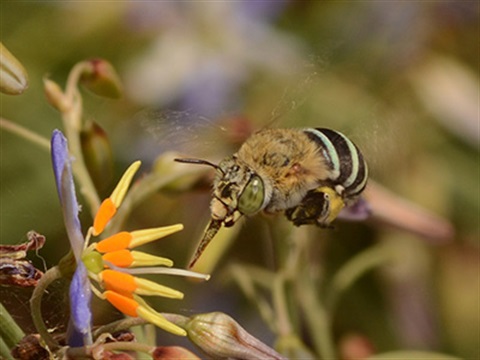Insects and pollinators

Our backyards and bushlands are host to many beneficial insects. They help maintain healthy ecosystems by supporting plant growth, controlling pests and improving soil health.
Here's why they are important:
- Native bees, butterflies, moths and beetles pollinate flowers, helping native plants, fruit trees and vegetables produce seeds and fruit.
- Many Australian plant species rely on native pollinators to reproduce, such as eucalypts and banksias.
- Beneficial insects like ladybugs, praying mantises and wasps keep pest populations in check, such as aphids and caterpillars.
- Some beetles break down organic matter, enriching the soil with nutrients and promoting better soil structure.
- Insects are a food sources for native birds, frogs, lizards and mammals, supporting biodiversity in your backyard.
For more information on how to attract pollinators to your backyard, our Backyard Biodiversity project has a number of resources available.
Insects of Central Victoria
In the warmer months our backyards, farms and bush blocks are abuzz with butterflies, flies, bees, bugs and beetles. Did you know we have a nature guide to help you identify these beneficial insects, Insects of Central Victoria. The guide features insects that are likely to be observed in your garden and nearby bushland – with a surprising number of native bee species, moths and native flies. These insects are much better adapted to pollinating our local flora than the introduced honeybee and do a great job in your vegetable garden as well.
The Upper Campaspe Landcare Network led the project to develop the guide, with partners Wombat Forestcare and local councils.
The Pollinator Project
Recognising the role that indigenous pollinators play in maintaining a functional ecosystem, and the threats that they are facing, the Upper Campaspe Landcare Network (UCLN) developed the Pollinator Corridor Project – a cooperative, inclusive ongoing program designed to encourage the enhancement, establishment, and preservation of native pollinator habitat through the creation of Pollinator Corridors on private and public land.
Pollinator corridors are like biodiversity corridors designed for larger species, but pollinator corridors do not necessarily restore or protect habitat; instead, they can be designed and built in the middle of landscapes dominated by humans, such as agricultural land and urban streets.
The Upper Campaspe Pollinator Corridor Project is open to everyone. Your contribution can be as large as a field or roadside or as small as a flowering potted plant or butterfly puddler. Provided you can offer a sheltered spot, a safe waterer and year-round flowers, there will always be something in your garden, regardless of its size, to tempt pollinators to visit.
Free webinars, workshops and field days will run throughout the year across the Upper Campaspe Catchment, and you are invited to participate in them all.
Contact the UCLN to learn more about indigenous pollinators and how you can create healthy pollinator habitat and become involved in the Pollinator Project.
Victorian Pollinators Guide
The Common Pollinator and Beneficial Insects of Victoria(PDF, 3MB)guide in an identification and conservation guide that provides a good starting point, noting that many species can look similar.
Along with the guide, Port Phillip and Westernport CMA have shared a short video "Planting native vegetation for beneficial insects and improving on-farm biodiversity". This video they take you through a berry farm in that is part of a trial around the use of beneficial insects for biological control and pollination services, as well as reducing the need for insecticides to control pest insects.
Image credit: a busy native Blue-banded bee on matted flax lily (Dianella amoena) © John Walter